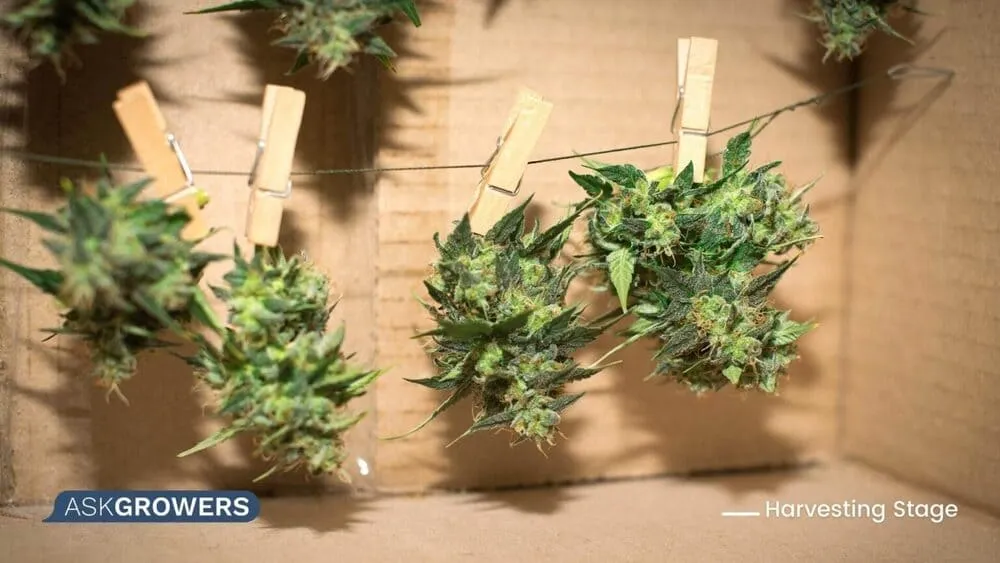Harvesting is one of the most rewarding aspects of growing cannabis plants. This is the moment the grower has been waiting for since the first sprout. It would seem that the difficult way behind, the buds are ripe, all is left to do is to cut the bush, and you can try the crop. However, it is not as simple as it seems. Harvesting is done in several stages. Plants are trimmed and their flowers and leaves are collected. These are dried and then properly processed to ensure quality output.
Only properly conducted harvesting can ensure that the crop is ready for further storage with the maximum percentage of psychoactive substances, as well as the preservation of all medical and flavor properties.
Harvesting Marijuana Buds: Step by Step
Experienced growers claim that the last few days before the cannabis harvest is better spent in complete darkness. Prolonged exposure to darkness is stressful on plants and triggers protective mechanisms, one of which is active resin production. When the plantation is in the dark, the destruction of the chlorophyll begins. It negatively affects the taste of the product and gives it a hard taste of burnt grass. In the morning, right after the lights go on, you can start harvesting.
The “X” Moment
Harvesting weed too early can lead to undesirable results. This process should start with the determination of the maturity of plants and their readiness for harvesting. It is preferable to harvest cannabis in the morning, as cannabinoids reach their peak.
It is easy to determine that marijuana is ready to harvest. Some cannabis growers harvest their crop, guided by the advice of more experienced growers; others choose to find information in the literature. As a rule, the time when marijuana blooms breeders predict with good accuracy, give or take a week. When the time comes to harvest, inspect your bushes on a regular basis. To give an example, if a seed manufacturer claims that a certain variety of seeds has a flowering period of 7 to 9 weeks, you need to be ready at the beginning of the seventh week to trim the inflorescences.
Be patient during harvest time, as it is only with a careful approach that you can collect the highest-quality crop. Also, as the trichomes mature and change the color you can use them to determine the harvest’s maturity. By watching the subtle changes in the color of cannabis flowers, you can tell when the crop is ready for harvest.

Trichomes are glands that cover bushes and produce resin. They look like thin hairs with tiny bubbles at their ends. Depending on the genetic traits of a strain, trichomes can be of different colors and can vary in size. The color of the bubbles tells the cannabis grower a lot about the progress of their plants. When collecting data, growers use a magnifying glass for viewing the plants (a 40+-time enlargement makes it easier to see the plant’s growth).
If bubbles are transparent, it means that you have immature inflorescences; the fruits need to be left on the plant a little longer. If by studying the trichomes you will see that their color has changed, they have become cloudy and have acquired a cream shade, it is a signal that the inflorescences have reached their maturity and contain the maximum amount of THC, CBD, and CBN. The buds will be more potent and you’ll get the highest quality effects. This applies to both Sativa and Indica strains of marijuana.
Dark amber trichomes confirm that the inflorescences are fully mature. Such buds will please you with a powerful sedative effect even under the domination of the genotype of Sativa genes.
As a general rule, the ripening of trichomes can be uneven. For instance, on the lower inflorescences, they may be already amber; while on the upper ones, they may be just beginning to blur. Some growers advise not to wait for 100% of trichomes to change color and decide when to cut the plant-based on a shade that achieves 70% staining on more than 50% of the plant’s fibers. If you wait until all trichomes are colored before harvesting a crop, you risk losing half of your plants to over-pollination. This results in a decrease in flavor and aroma production and less of an effect.
Drying
For the maximum preservation of the cannabis harvest, it is necessary to properly cut and dry buds, as the accuracy of these manipulations also largely depends on the quality of the obtained marijuana. When grown outdoors, the plant is removed in the early morning, with the first sunlight, and in the indoors, the shoots are cut in the dark, before the light turns on. This step requires the grower to strictly perform some of the intricacies of the process, as any errors in this part of the work can lead to the breakdown of THC, which, understandably, will negatively affect the quality of the fruit.

To harvest cannabis smoothly and without excesses, and maintain the crop’s high quality, cannabis farmers advise that you comply with some conditions.
The cannabis drying must be carried out:
- At ambient humidity from 50% to 60%;
- At ambient temperatures ranging from 64,4 °F to 68 °F;
- In the dark or at the maximum dimmed light, as light contributes to the rapid decay of THC. Alternatively, green light can work, because it reflects from the plants.
Manicuring or Trimming
To save resources, it is recommended to remove the large leaflets that aren’t necessary for photosynthesis. Some cannabis growers prefer to conduct trimming at a time when the bushes are still growing on the seedbed, while others begin to perform this phase only after the bushes dry.
Curing
At this stage, the final drying of inflorescences is performed. Curing is a very long period, it can last several weeks or more. At this stage, cones are sustained without oxygen in the dark. This increases the organoleptic properties of the product and also makes it more effective without external effects.
Conclusion
Harvesting is the most anticipated time for every marijuana grower. Yet, it requires a lot of care and effort to perform it right and to get the most from the crop. Whether you’re harvesting seeds from cannabis plants or buds, you need to monitor the light and temperature around your grow boxes to ensure that the cannabis harvest will please you with a top-notch effect.

